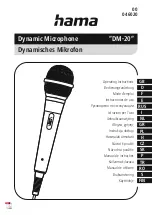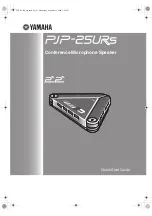
Specifications
†
Operating Principle
..............................................Condenser
Polar Pattern
........................................Continuously-variable
Frequency Response
......................................40Hz - 20KHz
Sensitivity
..........................................-29dBV (35mV) @ 1Pa
Impedance
............................................................135 ohms
Self Noise
....................................................................22dBA
Maximum SPL
..................................110dB, 1% THD, 1KHz
Power Requirements
............................P12, P24, P48, 4mA
Connector
..................................................3-pin XLRM-type
Polarity
................................Positive pressure on diaphragm
corresponds to positive voltage on pin 2
relative to pin 3 at XLRM-type connector.
Finish
..................................................................Matte-black
Dimensions
......................................................(See drawing)
Net Weight Mic Head [Mass]
........................1.1oz [0.03Kg]
Net Weight Control Box [Mass]
....................12oz [0.34Kg]
Packaged Weight [Mass]
..........................1lb 14oz [0.85Kg]
RF Immunity
........................Meets or exceeds EN55103-2,
E1, E2, E3 and E4
RoHS Compliant
†
Specifications subject to change without notice.
Included Accessories
....................................40-347, 40-354,
Articulating Steel Hanger.
Optional Accessories
........................................MB-1, RU-1.
The microphone will be an overhead-condenser type
designed to be suspended or mounted on a boom
(Astatic MB-1). The microphone will have a continuously-
variable polar pattern controllable from the remote-control
box connected by a two conductor shielded cable. The
sensitivity of the microphone will be –29dBV (35mv) @
1Pa. The frequency response will be 40Hz - 20KHz. The
impedance of the microphone will be 135 ohms. The self
noise will be 22dBA. The maximum SPL will be 110dB. The
microphone will include a selectable 80Hz, 12dB/octave
high-pass filter controllable on the remote control box for
increased intelligibility.
The microphone will have a TB3M-type connector on the
rear of the microphone element enclosure. The control
box will have 3-pin XLRF-type input and 3-pin XLRM-type
signal output. The microphone will operate on P12, P24 or
P48 standard phantom power consuming 4mA. The micro-
phone element and electronics will be enclosed in radio
frequency resistant housings meeting or exceeding
EN55103-2. The microphone element enclosure will be
1-11/16" [43mm] long, 3/4" [20mm] in diameter. The net
weight [mass] will be 1.1oz [0.03Kg] not including the
cable. The microphone remote polar pattern control
enclosure will be 4-9/16" [116mm] long, 2-7/8" [72mm]
wide and 1-5/8" [40mm] high. The net weight [mass] will be
12oz [0.34Kg] not including the cable. The packaged weight
[mass] will be 1lb 14oz [0.85Kg]. The 1600VP will have a
durable matte-black finish.
The Astatic model 1600VP is specified.
Omnidirectional
Cardioid
Figure-of-eight
Astatic Commercial Audio Products
6573 Cochran Rd. Building
I
Solon, Ohio 44139 U.S.A.
Tel: (440) 349-4900 Fax: (440) 248-4902 Sales: (800) 421-3161
www.astaticinstalled.com
1600VP
Continuously-variable Pattern Condenser Hanging Microphone System with Remote Polar
Control and Exclusive Anti-rotational Positioning Mount
2 of 4
3 of 4
The connection cable between the microphone element enclosure
and the control box is to be two conductors, with a braided shield-
cable. (Existing microphone wiring, such as mic cable or an Analog
Audio snake can be used).
1.
Connect the microphone head to the TA3F-type connector
of the cable provided.
2.
The Female Plug on the control box will accept the 3-pin
XLRM-type cable from the microphone element enclosure.
3.
Connect the 3-pin XLRM-type to an audio mixer or recording
providing phantom power (P12, P24, P48).
4.
When all connections are made and phantom power is applied
the Blue LED on the control box will illuminate to indicate
proper connection to the mic head.
5.
Adjust the polar pattern as desired.
6.
Use the white spaces to label the control box.
Final Connections
Architects’ and Engineers’ Specification
VPC-1 Variable-pattern Control Box
Top View
Microphone Head
VPC-1 Variable-pattern Control Box




















